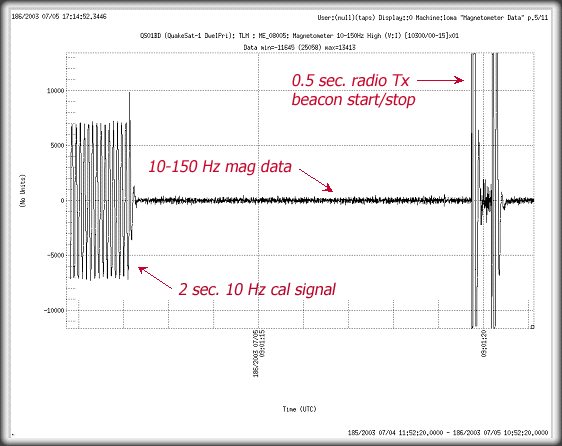



This weekend we achieved a major milestone in on orbit operations by successfully beginning to download both payload magnetometer and housekeeping data (magnetometer data shown below). Overall in first week in orbit, QuakeSat is operating well, and appears to be in good health.



All 12 solar panels appear to be working based on intermittent solar array current data taken. The two battery packs appear to stay fully charged in the sunlight, and show nominal discharges during eclipse periods. In addition, the +5 and -5 volt power supplies are nominal.


The 1.2 Watt Tekk radio with 9600 baud and AX.25 packet system is working well. However, since QuakeSat is tumbling with a period of approximately 300 seconds sporadic antenna nulls are observed as the satellite spins, resulting in reduced download efficiency. The transmitter on the satellite appears to have a slightly higher center frequency than the nominal transmit and receive frequency of 436.675 MHz. Temperatures may be responsible for moving this up to 436.677, though further analysis will be conducted. A special thanks to Niels Holmgård Andersen (niels@holmgard.dk


QuakeSat is passively stabilized with four Alinco permanent magnets and one Carpenter 80 hysteresis rod along the magnetometer axis. Telemetry from an IR earth sensor and several temperature points show a tumble (or nutation) period of 300 sec (slowed from 128 sec at launch on 30 June). The loss of the continual solar panel current data will make it very difficult to estimate the satellite’s coarse attitude and spin/nutation rate.


QuakeSat is being tracked by NORAD and is labeled as object 27845. The orbital elements are: NORAD
| Number | Epoch | Incl | RAAN | Ecc | AoP | MA | RPD |
| 27845 | 3185.17316710 | 98.7250 | 192.0436 | .0008013 | 311.8441 | 48.2047 | 14.1951385 |


All temperatures are within limits, and it appears that the temperatures are starting to stabilize. Here is a sample during real time contacts. All temperatures are in degrees Fahrenheit:
| Component /DateData taken | 7/1/03 (F) | 7/5/03 (F) |
| Transmitter temp | 94.7 | 99.2 |
| Computer temp | 119.8 | 124.2 |
| Battery 1&2 temp | 80.2 | 84.9 |
| Battery 3&4 temp | 80.0 | 84.9 |
| Pos 5V temp | 120.1 | 124.4 |
| Neg 5V temp | 101.6 | 106.3 |
| Structure temp | 85.8 | 90.6 |
| Payload temp | 82.8 | 88.3 |
| Boom temp | 64.2 | 71.77 |


The Stanford Ground Station (SGS) was designed and built by a Stanford PhD Student, Jamie Cutler. (Fantastic job!) It has a 15 db gain Yagi antenna, mounted on a 15 ft mast, on top of the fourth floor of the Durand Bldg on the Stanford University campus. It uses an ICOM preamp and ICOM 910H transceiver with 9600 baud packet capability. Jamie has developed his own packet transmit/receive software that uploads and downloads packets in an AX.25 format. The data is received, buffered and transferred to the QuakeSat Mission Control Center (MCC) via FTP. The site has worked beautifully, and after minor software “tuning” we are getting 400-500K files from the satellite each contact--on high elevation passes.
Several of photos of the ground station radio equipment is available here . Also, the majority of the ground station is operable by scheduled users through a Web interface that can be viewed at http://gs.stanford.edu/